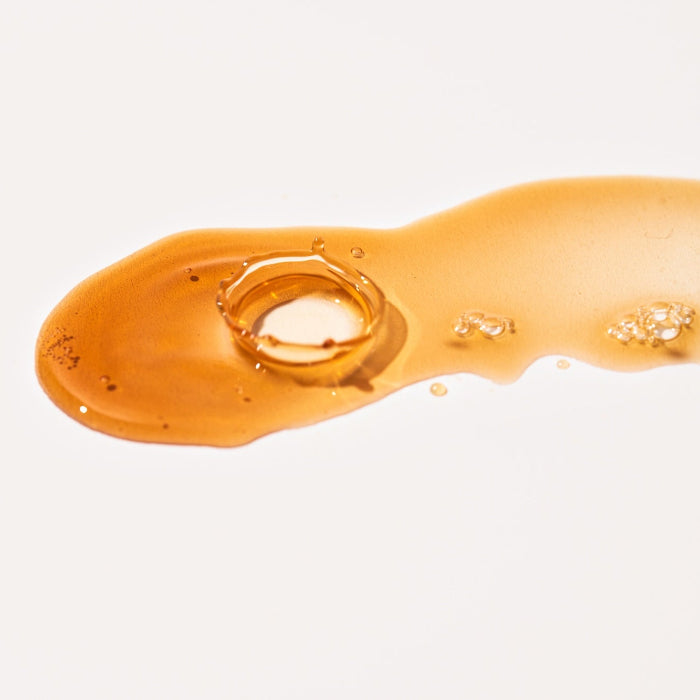This low molecular weight protein isn’t a random sequence of amino acids - it’s targeted to have lysine-rich peptides that make it affinitive for hair.
Pisum Sativum (Pea) Peptide
Everyone knows peas are an incredible superfood, but not everyone knows pea peptide is one of the best proteins for topical use!
Pea Peptide is a balanced hydrolyzed protein around 2000 Da in weight. Thanks to its lightweight, film-forming properties, this peptide forms an invisible, protective barrier on hair and skin. In fact, Pea Peptide is one of the most substantive vegetable proteins to hair and skin. The result? Skin that’s moisturized and hair that appears less frizzy, more voluminous, and feels soft to the touch.
- at just 2%, performs equally to hydrolyzed wheat protein to increase hydration
- at just 2%, increases hair fiber diameter by 13.65% after one hour
- at just 2%, protects hair from pollution particulate that causes oxidation of the hair fiber
- at just 0.1%, offers significant antioxidant protection to skin, reducing ROS
Pea Peptide is one of Valerie’s favorite proteins for hair (and she has several!). Not much protein is needed to improve the look and feel of hair, so she recommends to start out at 0.5% or 1.0% of the peptide. Keep in mind Pea Peptide has a slight negative charge—it can be used with positively charged ingredients that condition hair, but keep an eye out for any incompatibilities. See details below for additional formulation guidelines!
While ordinary proteins undergo random hydrolysis, giving random peptide fragments, Pea Peptide is no ordinary protein. It’s derived from fermentation of pea biomass, which produces specific peptide fragments rich in lysine, a basic amino acid. This allows the peptide to stick efficiently to hair.
Peas are sourced from a family-owned farm in Michigan that uses organic, regenerative farming practices. The peas are dried and mechanically milled into a powder. The pea powder is then fermented with Lactobacillus Bulgaricus. The protein fraction spit out by the bacteria is then isolated through filtration. The product is then safely preserved with Leuconostoc/Radish Root Ferment Filtrate.




Pisum Sativum (Pea) Peptide
| Pisum Sativum (Pea) Peptide | 98% | (CAS 90082-41-0) |
| Leuconostoc/Radish Root Ferment Filtrate | 2% | (CAS 1686112-10-6) |
Readily Biodegradable (87.3% biodegradable after 28 days)
Pea Biomass - Michigan, USA
Fermentation - USA
Plant (Pea)
Plant (Radish, Preservative)
Bacteria (Preservative)
100%
100%
Hair - Increases fiber diameter, Smooths, Reduces Frizz, Antioxidant protection
Skin - increases skin hydration, Antioxidant protection
Shampoos, Conditioners (Rinse-off), Leave In Hair Conditioners or Stylers, Skin Moisturizers
| Shampoo | 0.5 - 5% |
| Rinse Off Hair Conditioners | 0.5 - 5% |
| Leave In Hair Creams | 0.25 - 5% |
| Skin Moisturizer | 0.5 - 5% |
Yes. Pea Peptide and Leuconostoc/Radish Root Ferment Filtrate have GRAS status with the FDA and are suitable for use in lip products.
Pea Peptide was found to be non-irritating in in vitro ocular studies. Products should bear an eye safety warning.
4 - 7
Pea Peptide is heat stable and can be added below 80ºC. It is recommended to add Pea Peptide directly to the water phase, but it can be added directly to emulsions.
Peptides can settle over time and form a sediment at the bottom of the container - please mix the container well before use.
Pea Peptide is anionic, (negatively charged), but it is compatible in cationic conditioning systems.
Brown / Characteristic Protein / Liquid
Water. Up to 40% in Alcohol.
N/A
22% Active Peptide
0%
Store in closed container in a dark, cool place.
Shelf life is only relevant to the date it was manufactured and how it was stored! Please use the retest date on the Certificate of Analysis below to see when this ingredient should be retested for continued use.
For external use only. Keep out of reach of children.
None
Safety Data Sheet
Certificate of Analysis Lot 24G158
Sold in ounces or pounds by weight. See our Terms for full warranties on safety & regulatory.
| 2 oz 4 oz 8 oz 16 oz |
Aluminum Bottle with Aluminum Closure Aluminum Bottle with Aluminum Closure Aluminum Bottle with Aluminum Closure Aluminum Bottle with Aluminum Closure |
Peas are harvested from a regenerative farm in Michigan.
The peas are pulverized and milled into a powder.
The pea powder is fermented with Lactobacillus Bulgaricus, a bacteria that spits out the peptide.
The pea peptide is collected and filtered out.




